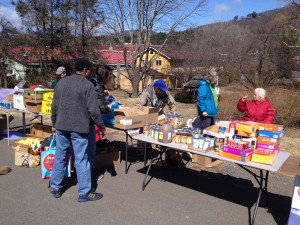Summertime
“What’s happened?” she asked with concern in her voice.
“What do you mean? ” I replied.
“What happened to the people?”
“Oh, that. Well, it’s summer.”
What’s happened is that the faces are often different in the pantry in the summer. When you’re living on the edge, when you’re a member of the Struggling Class, the change of seasons counts for a lot.
People who were too sick to make it to the pantry in cold are now able to make it out. How they manage to make it through the winter is a question for me. These shoppers barely get enough to eat as it is. How do they eat over the winter? Humans are not bears and don’t hibernate. What do these disabled do to survive?
And, yet, we have many in this category.
Some can’t make it to the pantry in the winter because their vehicles aren’t winter worthy. Beyond a certain temperature, the cars just don’t work. Then, as spring rolls around, they manage to get them running again to drive to the pantry during the warmer months.
Making it to the pantry in the winter is really difficult for the homeless. Truthfully, I don’t know how some of these homeless live in the winter. How they keep from freezing to death seems to me to be a miracle.
We lose some shoppers also. In the winter, men visit the pantry regularly because they don’t have work. Then, as the weather gets warmer, they find jobs and can’t come to the pantry because they’re working when the pantry is open.
We always miss these guys because they are good volunteers and really make a contribution to the pantry during the cold months.
One staple which carries everyone through challenges is peanut butter. Peanut butter is important to everyone in the Struggling Class.
It is important because it:
can be eaten right out of the jar.
needs no refrigeration.
has a long shelf life.
is not necessary to have teeth in order to eat it.
does not have to be combined with another food in order to be palatable.
is nutritious.
does not usually come in a container requiring a can opener.
is not necessary to cook it.
The only hitch to this whole wonderful story about peanut butter is that most of the time, there is no peanut butter in the food pantry.
The only time we are able to get peanut butter in our pantry is when we are having a peanut butter drive. It’s been months since we’ve had a decent amount, or any amount, of peanut butter.
Can you help?
There are 2 ways you can come to our rescue:
Our pantry is open Mondays from 2 to 4 in the afternoon. I’m usually there by 10:00 am.
On Tuesday mornings from 9:00 to 10:00 we are in the pantry packing the take out bags.
If you live/work in the area and want to bring some peanut butter to the pantry, we’re happy to receive it then.
If dropping the peanut butter off at the pantry is not convenient, we’ll be happy to accept your donation and purchase the peanut butter for the pantry. Please send the check to: Reservoir Food Pantry, P.O.Box 245, Boiceville, NY 12412.
We thank you in advance for this generosity. Currently, we serve over 150 households each week. Everyone needs peanut butter.
Peace and food for all.
Thurman Greco
Thank you for reading this blog post.
Please share this article with your preferred social media network.
Don’t forget to join the email list.
Support a Homeless Friendly Pantry
“In a land of great wealth, families must not live in hopeless poverty. In a land rich in harvest, children just must not go hungry.” – Lyndon B. Johnson
So, what is a homeless-friendly pantry? What makes a pantry homeless friendly, anyway? And, how can I support such a pantry?
For starters, a homeless friendly pantry doesn’t require discriminatory identification. Homeless people living in their cars or on the porch of an unoccupied home, or in an abandoned building cannot offer proof of address. Nor should they be asked to. A shopper’s address does not belong on the list of needed information.
A homeless-friendly pantry stocks foods which homeless people can eat. Those foods include fruits and vegetables which can be eaten raw. Canned goods for homeless people have pop tops which don’t need can openers.
A homeless friendly pantry offers salads in containers that homeless people can eat out of. Salad dressings are best in small packages or containers.
Individual containers of yogurt, cottage cheese, are good choices along with small containers of milk, juice, and packages of cheese.
Peanut butter, jelly, crackers, and bread are essential. Protein bars and cereal bars should be available at all times.
A homeless-friendly pantry offers at least five items of canned/boxed/bagged food per person to a household.
A homeless-friendly pantry offers 50% fresh produce to its shoppers. Produce which can be eaten raw such as carrots, cherries, lettuce, celery, sweet peppers, is very important to the health of a homeless person to have access to fresh fruits and vegetables.
The most important thing a homeless-sensitive pantry offers is a respect for all shoppers regardless of their living conditions, their health issues, and their disabilities.
The best way to support a homeless-friendly pantry is by sending money and donating food.
Thank you for reading this blog/book.
Please share this article with your preferred social network.
Please send a comment.
Peace and food for all.
Thurman Greco







